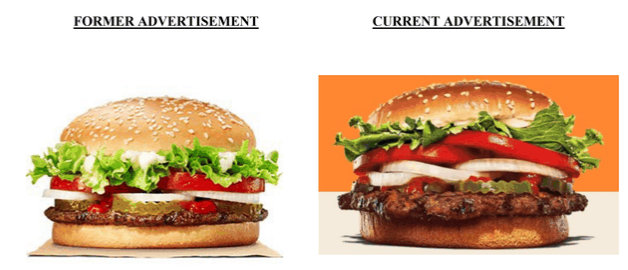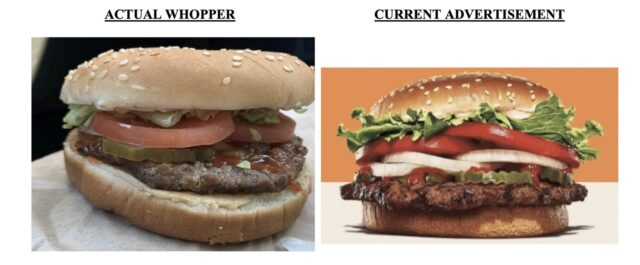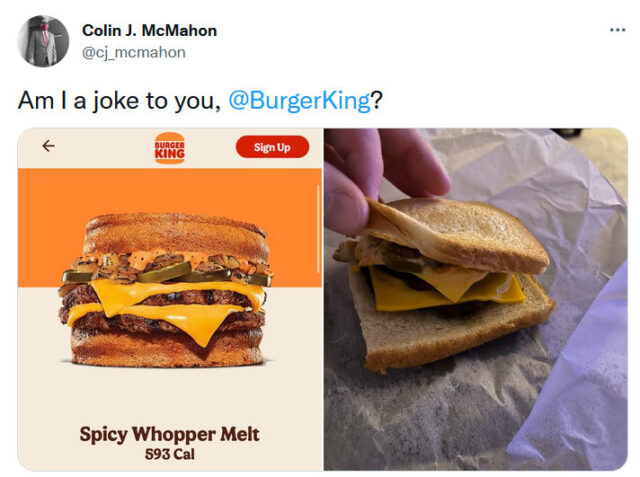A class action suit has been filed against Burger King by a number of customers for ‘false and misleading advertising concerning the size difference between food marketing photos and reality.

The lawsuit filed in the Southern District of Florida Court includes four plaintiffs, whose layer argues the marketing photos of the Burger King ‘Whopper’ has increased by approximately 35 percent, with the beef appearing 100 percent larger. This is despite the real product remaining the same size.
Since fast food became a staple in the Western diet, there has almost always been a discrepancy between the professional marketing photos making the food look perfect, and the real product. But the lawsuit claims that the marketing photos in September 2017 is when Burger King, AKA Hungry Jacks in Australia, ‘began to materially overstate the size of its burgers’.
The following comparison photos, including old and new marketing photos as well as customer photos, are from the lawsuit:
The lawsuit then goes on to highlight examples where the crème de la crème of culinary experts, YouTube food critics, criticised Burger King for making pictures that mislead customers of its portion sizes.
An American ‘expert fast-food critic’, John Jurasek, said in a YouTube video that the Burger King Big King Burger photo ‘makes you think that this thing is like, you know, two pounds or something, that it’s going to be this massive, massive, sandwich.
‘It’s not that big. For six bucks, you know, the size is a little disappointing.’
Inside Imaging contacted award-winning Australian food photographer, Paul Williams, for his take on the photos. His ethos is that a great food photography shows the ingredients, while managing a expectations.

‘I stand by what I know to be true. Fast food is shite and presented terribly. Shooting it as it comes, would demonstrate nothing of what the burger contains, as it’s all hidden – often within a semi-collapsed/crushed bun! Great photography manages expectations by showing what’s in the burger. For instance, the above, I feel is a pretty accurate representation. One was shot in five seconds. The other, five hours. The actual product itself is not so different, but of course the photography standard is’
His food photography website, Gold Coast Food Photographer, has an in-depth FAQ section that touches on the topic of fast food marketing photos.
What do you mean “…we show how your food tastes?”
We’ve all seen the food photography produced for McDonald’s burgers. Many feel that it’s misleading, once handed their horrific looking meal. But there’s a reason why shooting one McDonald’s burger takes 8-14 hours and they pay the best in the business TENS of thousands of dollars to shoot it. Because McDonald’s marketers have been doing it long enough to know that low quality photography results in low sales figures. This remains the unquestionable truth about food photography’s worth. Food Stylist’s and Photographer’s skills manage a customer’s expectations, even in this most extreme of examples that I’m giving. There is no greater example of ‘misleading’ food photography than the McDonald’s burger. Shooting the burger ‘as it comes to you’ in the restaurant however, would offer very little clue as to what’s actually in it, yet thanks to great photography, nobody is surprised about the content of the burger once they’ve bitten into it.

Although Paul feels other Burger King marketing photos in the lawsuit, such as the Spicy Whopper Melt, where the customer comparison image shows how truly woeful the product is, better demonstrates how the fast food company is potentially misleading customers’.
The lawsuit highlights how this ain’t Burger King’s first time being accused of misleading customers with portion sizes, with the UK’s Advertising Standards Authority (ASA) bringing the hammer down 12 years ago. The ASA ‘examined the size of an the burgers in the hands of average-sized man and considered that they did not fill the hands to the same extent as the burger features in the advert’. ASA agents also purchased three burgers and were apparently dismayed with the size.
The lawsuit rounds off its argument to conclude that Burger King’s advertisements are ‘unfair and financially damaging consumers as they are receiving food that is much lower in value than what was promised’.
‘Burger King’s actions are especially concerning now that inflation, food, and meat prices are very high and many consumers, especially low income consumers, are struggling financially’.
Read the court document here.





At last,someone has actually litigated the cynically manufactured difference between the Burger and Chicken products on TV ads and the harsh reality of what you actually get at the counter. This has to be false advertising, here in Australia as well as US, because these companies “sell the sizzle” visually on TV and then hand you a much lesser product. Hopefully someone reacts similarly in Australia and holds these companies to account. Any food photographer will tell you about all the tricks used to make these products look better than they really are.